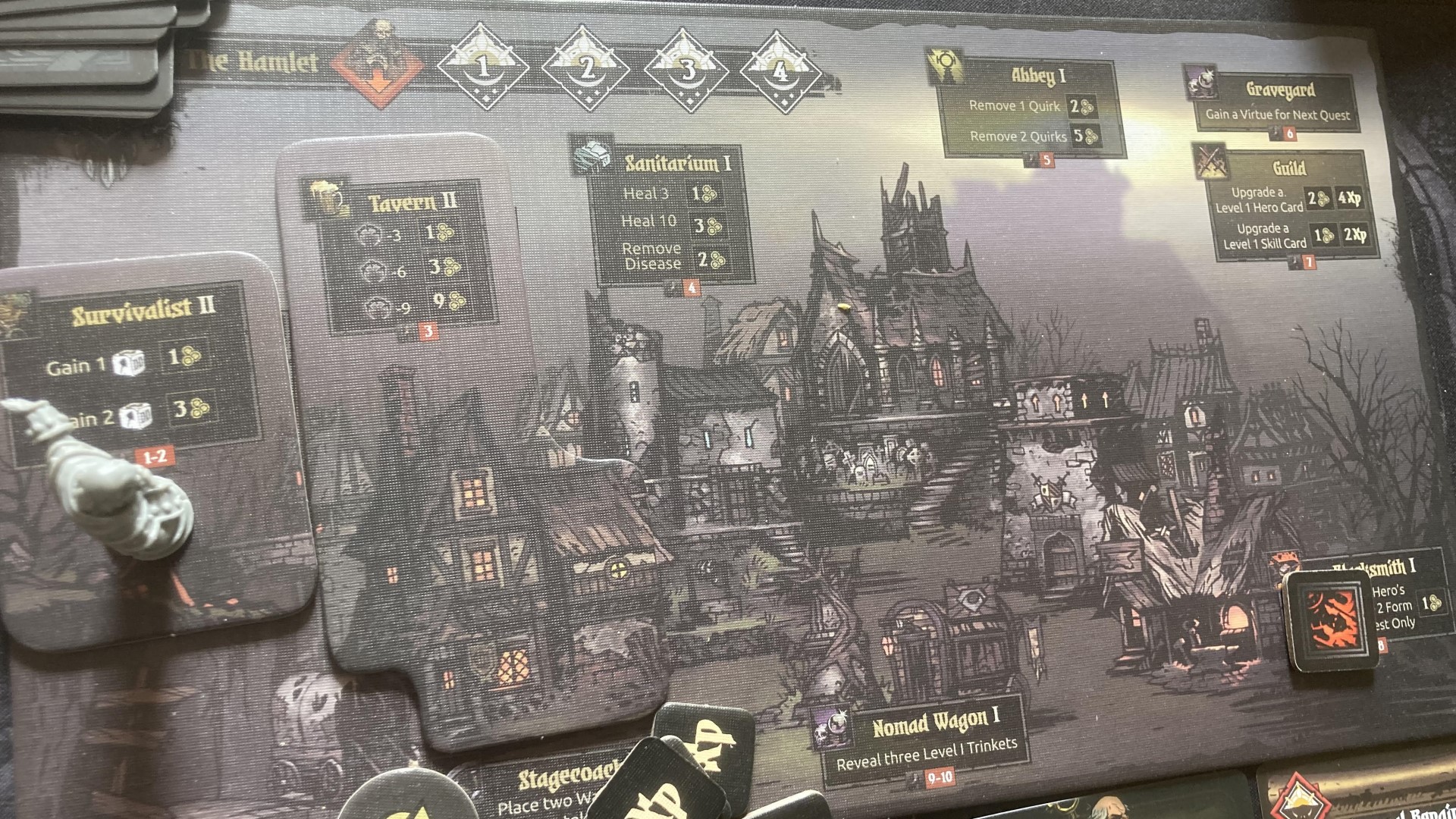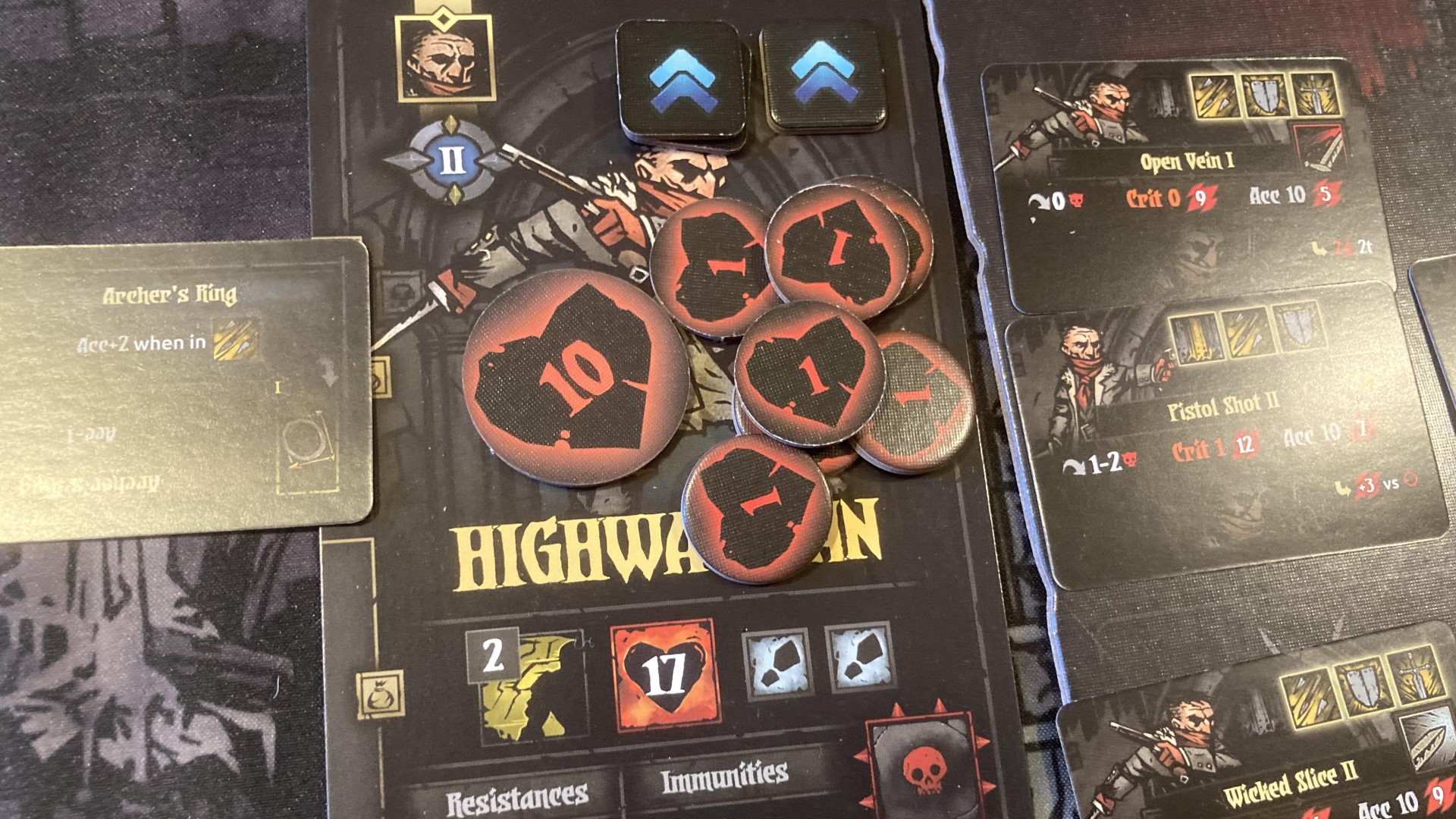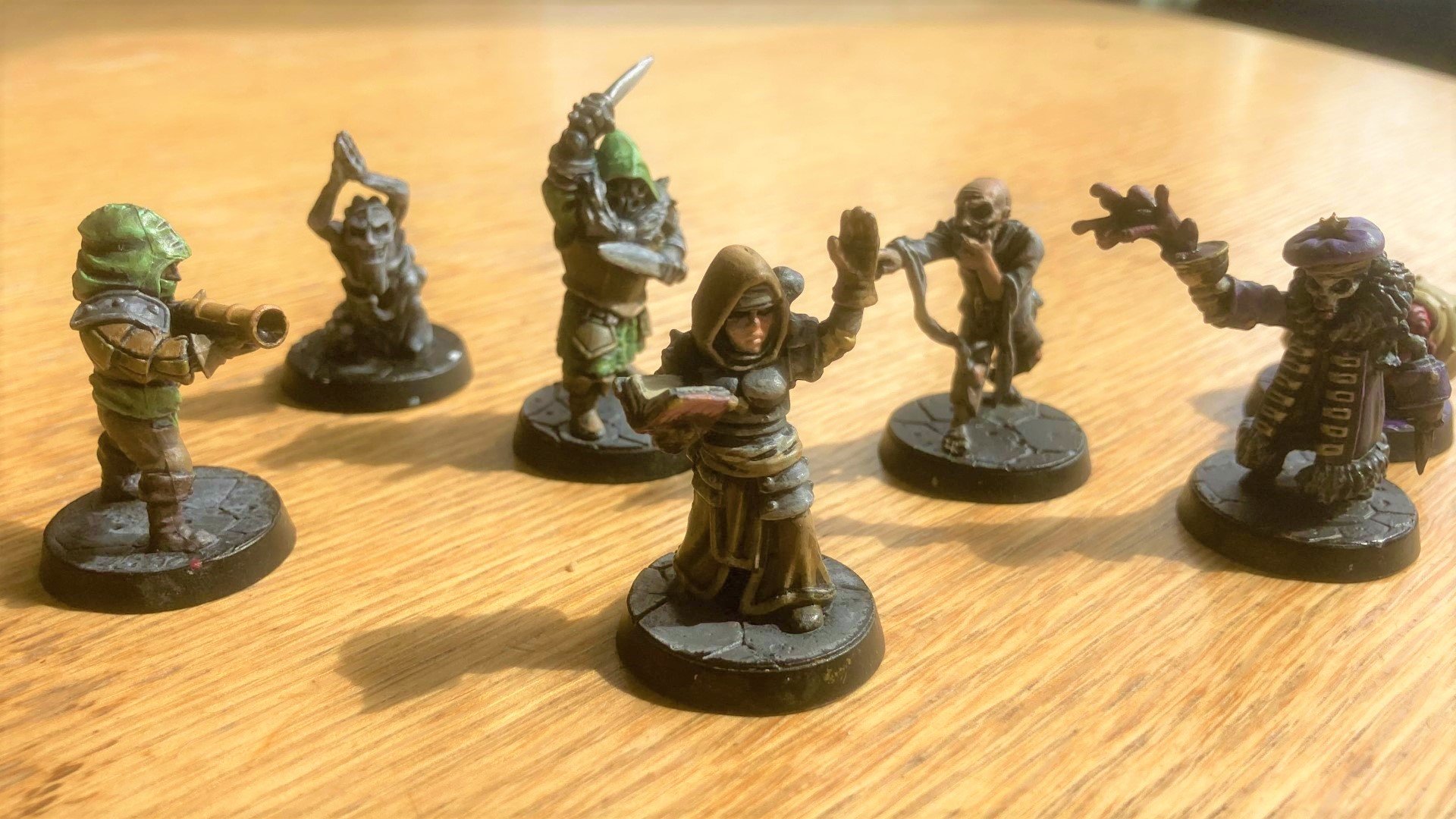Ruin has come to our family… The best thing about the Darkest Dungeon board game is how well it replicates the feeling of playing that much-loved roguelike title, despite having a lot of subtle differences to its video game ancestor. A horror themed roguelike RPG about the psychological impact of diving into terrifying eldritch dungeons, the digital Darkest Dungeon was as fantastic as it was frustrating.
And while the Darkest Dungeon board game looks the part – from the artwork on components to the stunning minis – under the hood it’s quite a different game. However, when you’re wondering if you can push your party of stressed out, neurotic, limping adventurers just a little bit further, down one last corridor, through one last battle, it’s unmistakable, that sensation of balancing on a knife’s edge. Even when things are actually less dangerous than they appear, the game instils the feeling that you’re scraping by with not quite enough resources, needing to be lucky if everyone’s going to make it out alive.
In adapting Darkest Dungeon to the form of a co-op board game, the designer Mythic Games has brought over every mechanic worth mentioning. Your heroes can develop negative and positive quirks and diseases; they can get so stressed they gain an affliction or die of a heart attack. Rather than toppling over when their health is all gone, you get a tense death’s door die roll each time further damage is taken, and where your guys are positioned in the marching order determines what abilities they can use.
Of course, not everything works quite the same way it does in the video game – there are some neat innovations. For instance, rather than providing a static benefit and drawback, trinkets can be used once to gain a boon, but then you have to suffer a penalty at a later date to flip them back. My point is though, that it’s a very faithful reaction, and everything (from the Ruins and Darkest Dungeon portions of the game) is here.
The biggest change you’ll find in Darkest Dungeon: The Board Game is the approach to combat. It’s less abstracted, with every fight taking place on a game board representing a room, each with their own fun quirks like healing fountains or spike pits. Each hero or monster has a position on the board, and needs to get in range before using a move. Hence, you’ll find over 100 minis in the game, which makes up the bulk of its weight (and likely of the price tag too).
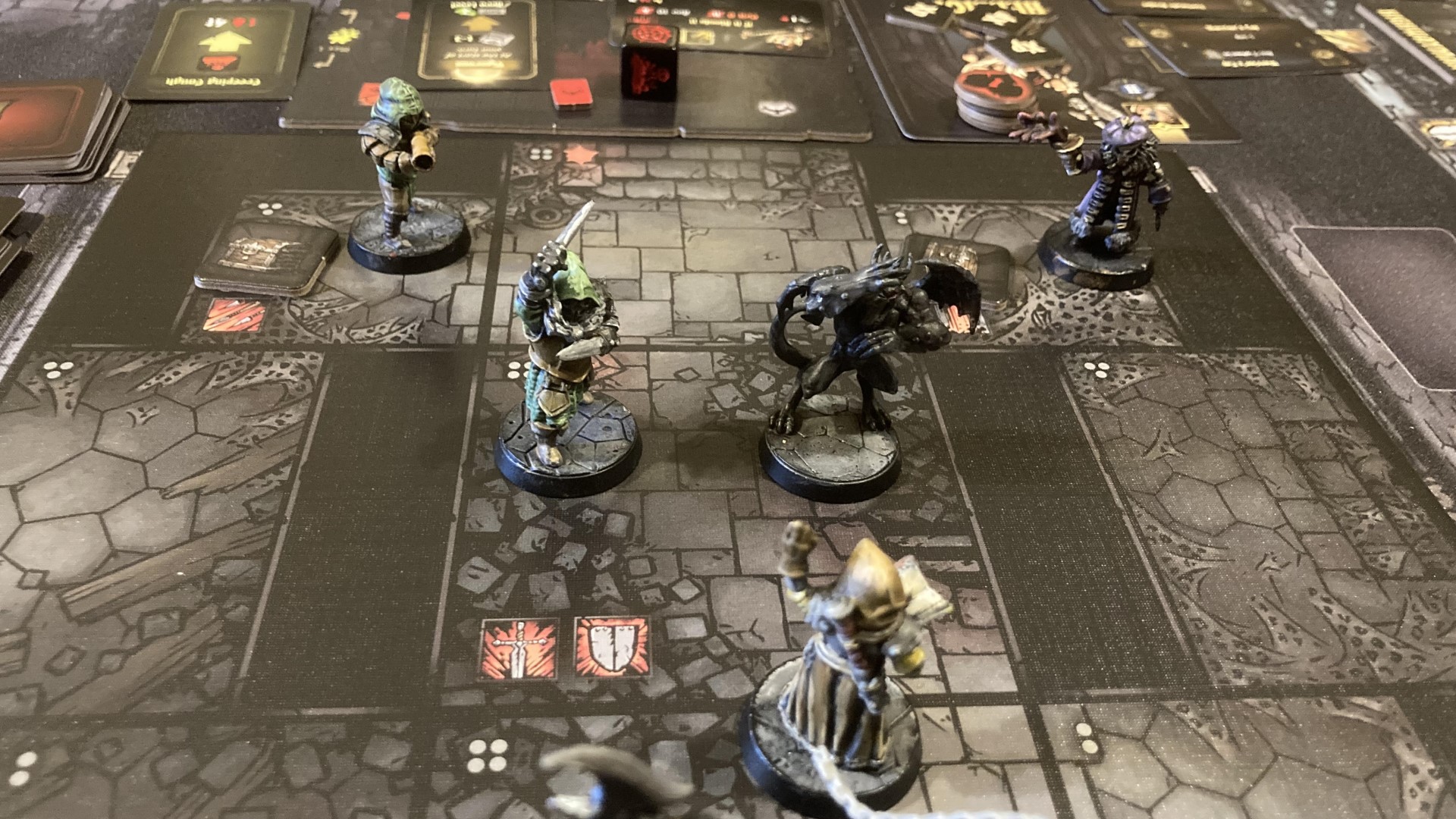
Dicing with death
Overall combat is fun, but not hugely tactically complex. Each hero will have a few different skills they could use each turn, but there’s usually a pretty clear ‘best move’ to make – though needing to think about positioning, range, and which beast to prioritise does lead to some more difficult moments. It’s enjoyable when you crash through a fight effortlessly, and gruesome when you take a major hit. Combat uses a D10 ‘roll-under’ system, and you can quickly get swept into the drama of the dice, cheering at lucky misses and crits, and wincing when the bones aren’t on your side.
The system is hampered, though, by some rather odd design choices. First off, like in the video game, heroes and monsters have a position on a 2D plane which determines order and which moves they can use (generally you need to be further back to use ranged or healing abilities), but this doesn’t reflect their actual position on the 3D board. Except it’s also not entirely separate from it, as pulling and pushing moves affect your position on both the board and the stance tracker. It’s perhaps a personal quibble, but I found this pretty hard to wrap my head around.
A more objective complaint is that the battles can feel like video game fights with bad AI. The rules dictate how a monster chooses its target: some want to bully your most stressed hero, others seek to hurl a ranged attack at the furthest target. They then attempt to reach your hero, running straight at them to use their ability. But if they can’t get there that turn, instead of fighting someone who was in range, they’ll just skip the rest of their turn and do nothing. They might have started right beside a juicy target, but then get an urge to hang out in a corridor instead. At worst, it feels silly, and like you’ve won through exploits rather than tactics. My very first fight, most of the monsters died on turn one after diving into a spike pit.
At first, I found combat was pretty unthreatening, and the main dangers lay in the corridors, but, thanks to factors like a random initiative order, it’s more that it’s swingy. If some of your heroes get to act first you can usually dispatch a monster or two, and then draw out the encounter as long as possible while you heal, or pick up the treasure. (You’re incentivized to do this, as the battle ends instantly once the last monster breathes its last, meaning you lose all looting or healing opportunities.) But if you take a few unlucky crits, it can all go pear-shaped very quickly.
Luck and challenge
Darkest Dungeon is not the game for you if you don’t enjoy RNG. It’s not that there aren’t lots of meaningful decision points (when to make camp and heal, what skill to use in battle) but generally you’re deciding how to spend your resources to deal with whatever fate throws at you. I like this. I particularly enjoy the hamlet phase between each dungeon delve, where you have a (randomly determined) number of days to spend cash healing up and preparing for the next ordeal – but there are a lot of random systems at play here.
Indeed, many aspects of Darkest Dungeon turn on the roll of a dice: from the hazards you encounter in corridors, to the provisions you’re given to take care of them. Turn order, the level of monsters that show up, and the abilities they use (if they waste a turn for instance) will have a major impact on combat – perhaps even more of an impact than anything you do – and are all 100% random. Sometimes, no matter how you try to mitigate risk, a hero will die because you stumbled into too many curios and they went mad, or the monsters all acted before any of your heroes and dogpiled the same poor sap.
Despite this, Darkest Dungeon is not as punishing an experience as you might expect, especially given its source material. Most battles you’ll glide through without too much trouble, and you can run back to town at any point outside of battle – deliciously this just encourages you to push your luck further. When a hero dies, they’re instantly replaced by someone from the stagecoach, as long as you have enough lives left. That character class is gone for the remainder of your campaign though – so death still has consequences. Most crucially of all, these replacement heroes immediately get levelled up to the same point as the rest of your party, completely cutting away the grind that forms a key part of the video game’s loop, but is also one of the most divisive things about it.
I think the decision to make Darkest Dungeon: The Board Game less brutal was a very good one. As tabletop adaptations like Dark Souls have shown, grind doesn’t work at all well in board games. When everything is more time consuming and requires more work, you don’t want to be repeating large chunks of gameplay in order to progress. This would be particularly bad in Darkest Dungeon: The Board Game, I think, due to how labour intensive the game is. Which leads me onto my main problem with the title…
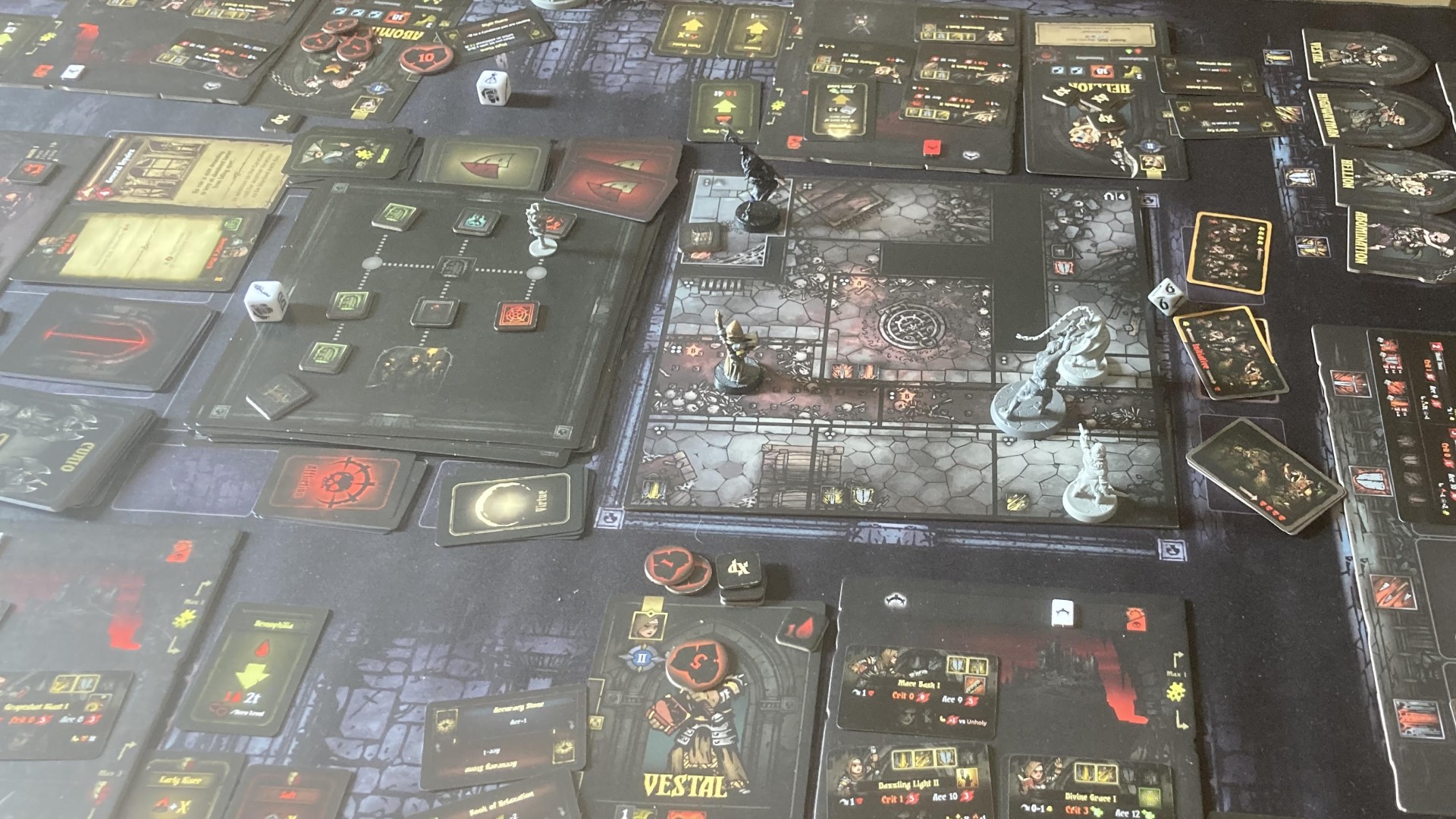
What horrors await?
Darkest Dungeon, I think, suffers from a minor case of Kickstarter bloat. With separate decks of cards for monsters, skills, trinkets, diseases, quirks, dungeon rooms, and so on, not to mention boards for the dungeon, rooms, hamlet, set up and tear down takes an age, and you’ll need a huge table to fit everything with some facsimile of order.
It’s fiddly too. You regularly have to shuffle irritatingly small decks of irritatingly small cards, or go digging in the box for new components. These are all well made but I still found myself disliking many of them. It doesn’t help that they’re so damn dark – the stress tracker in particular is basically unreadable. I couldn’t help but feel that maybe something could’ve been let out of this game. It could’ve sacrificed a little variety for extra playability and come off much better for the trade.
The counters are the worst offenders. Status conditions and damage are applied by piling separate towers of counters onto heroes’ and monsters’ cards and removing one each turn. But this becomes a faff very quickly, and worse, there’s not enough space for these piles, so the lovely artwork and even crucial information soon gets obscured. It only gets worse as the campaign progresses, and before long you’re squeezing six buff tokens beside seven damage and two stacks of bleed 3, and just trying to avoid knocking everything over, let alone remembering it all.
The game comes with reminder cards to reduce rules-checking, an admirable feature in a complex game. But you’ll still have to go back to the rulebook often, and I think it’s below average. It’s not just that it could be laid out better; it needs clearer wording, and there are plenty of oversights where situations are unclear and you’ll have to make up house rules. This can lead to the occasional awkward moment where you’re unsure if you’re gaming the system.
Overall, I’ve enjoyed my experience with Darkest Dungeon. It’s a good little dungeon crawler, with serviceable combat, some fun dice rolling, and a really good level of management on top. The main problem is how not little it is. From the way it plays, Darkest Dungeon: The Board Game feels like it should be a more casual light board game, but instead it’s a hulking great thing. I don’t think it quite does enough to justify its own enormousness. It feels like sacrilege to say it – the game honestly might work better with the 3D combat taken out altogether, and a 2D system that more closely apes the video game used instead.
Or at least that’s what I’d say, if I could bear losing the miniatures. I’ve left this for an aside at the end here, because I know not everyone cares about this sort of thing, but oh my gosh, they are so lovely. They’re excellent 3D recreations of the video game’s art assets, and you get a large number of them, with 118 in the core box. They have a perfect level of detail, with not too many mould lines, and I’ve been having a blast painting them up. There was only one model, the abomination’s transformation form, that had some weird gaps where parts were clearly joined.
It’s a treat to crack open the box and rifle through these minis, admiring the gruesome sights within. “I wonder if this will show up?” you wonder. “I hope it doesn’t”.
Mythic Games and its Kickstarter projects have attracted some controversy recently after requesting additional funds from backers. We chose not to take this into consideration in our review of Darkest Dungeon: The Board Game, aiming to assess the title based on its merits alone.
Hack, slash, and sob
As is often the case with Kickstarter titles, a little more restraint may have made the game better, but overall Darkest Dungeon is a fun and faithful recreation of the video game, adapted to the tabletop with only a few hiccups along the way.
Source: Wargamer




